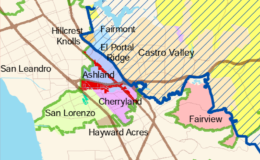If all of these facts are true and applicable in Alameda County, then I would ask one simple question: why don’t we do it NOW?
A Community Advisory Council – Better Than a MAC?
- By : Michael Baldwin
- Category : Featured Story, Governance
- Tags: CAC, MAC
One of the ideas being examined by the Eden Area Livability Initiative is that of having the Castro Valley Municipal Advisory Council (MAC) be an elected body rather than an appointed one. The County has reported that this would be very expensive, and not “economically feasible.” In a previous article, I examined Stanislaus County and looked into how they could have eight elected MACs in their County without bankrupting the area. Today, I will focus on one of the “MAC equivalent” groups I discovered in another previous post. A Community Advisory Council (CAC) could replace our MAC, be elected , and save the County a considerable amount of money. So, just what is a CAC?
A Community Advisory Council (CAC) is authorized to represent their unincorporated communities by the San Luis Obispo County Board of Supervisors in much the same ways as a MAC. Currently, there are 11 active Councils, serving over 58,000 residents in San Luis Obispo County.
In a previous post, I detailed the history of MACs. They came to be in 1971 via California State Code section 31010 which gave Counties the specific authority to create them. San Luis Obispo County decided to take a differerent approach. Development of the CACs goes all the way back to 1977, but eventually the process was formalized when the Board of Supervisors adopted a policy that formally established criteria for “Board-Recognized Community Advisory Councils” through adoption of Resolution No. 96-485 on December 10, 1996.

Under the resolution, Community Advisory Council must meet the following five criteria to be recognized by the county:
- A Community Advisory Council must be based in and represent a defined community within an establish Urban or Village Reserve Line, which can include representatives from outlying or surrounding unincorporated areas associated with the community.
- Community Advisory Council membership should reflect a broad cross-section of the community.
- Community Advisory Council meetings should occur regularly and be publicly noticed in a timely manner, and be open to all members of the public.
- Community Advisory Council by-laws should be established and maintained which direct the organization and protocol of the council. These should include a statement of purpose, the rules of order, frequency of meetings, and appointment or election of members.
- Recommendations made by the Community Advisory Council and forwarded to the Board of Supervisors or the Planning Commission should be arrived at by a majority vote of the quorum of the membership, with as much public input as feasible.
San Luis Obispo County also mandates that all CACs have a written set of by-laws that contain (at a minimum) these 11 elements:
- They must direct CAC protocol
- They must have a statement of purpose
- They must have rules of order
- They must have Conflict of Interest guidelines or policy
- They must identify frequency of meetings
- They must explain methods of appointments or election of CAC members
- They must explain methods of appointments of subcommittees
- They must acknowledges that CAC is advisory only and not a formal approval body
- They must state how CAC will transmit comments to the county
- They must encourage training
- They must state that all new members are to be provided with by-laws and a CAC handbook
San Luis Obispo County has created some really helpful standards for these CACs, many dealing directly with the tenor of their interation with the community. State law is very vague, meaning a MAC can be very structured or not structured at all. MACs, being Board created, are also subject to many other County regulations.
Cheri McKee, the Deputy Clerk of the San Luis Obispo County Board of Supervisors put it this way: “The substantial difference between the Advisory Councils and those that have been created by the California Gov. Code (MACs) is that the Board of Supervisors did not create the Advisory Councils, rather they recognize them as designated advisory bodies for their communities. If the Board had created those Advisory Councils then they would be subject to the Brown Act. This would require staff time and a formal process that is not necessary or helpful. The Advisory Councils are encouraged to operate in an open and transparent fashion and it is expected that this be part of their by laws.”
Because they are self-created, each CAC is unique in its mission, scope and its way of conducting business. Most CACs have elected representatives, but some also have appointed members who represent HOAs or special districts within the CAC jurisdictionl. Representation can be based on district precincts within the community , census tracts, groups or organizations, or a combination thereof. Elections are self-funded and conducted at set intervals. Many CAC elections are similar to the Altadena Town Council in Los Angeles County where members are selected by census tract. Some of the councils hold yearly public elections, some hold elections every two years.
Some CACs review all projects that are proposed in their area of interest. Others review only larger developments. Some have specialized “land use committees” that review all projects and only bring forward certain projects to the whole of the advisory council. This scope is determined by the needs of the community. They define their purpose through the creation of a Mission Statement. An adopted Mission Statement makes the role and the purpose of the CAC clear to its members and the general public who attend meetings.
Community Advisory Councils also often adopt goals and objectives. These can be changed from year-to-year to reflect the current Advisory Council’s interests and what they would like to complete during their tenure on the council. They should also reflect current issues and concerns of the community. This type of list detailing goals and objectives can be helpful when trying to prioritize the many duties of the council.
One of the CACs duties is to advise the county decision-makers on current and future planning matters. This is where CACs interact with staff from the Department of Planning and Building, much as our MAC does. The council makes recommendations on proposed plans and ordinances and development proposals for their areas. They make recommendations based on the wishes of community, again just like a MAC. Each CAC is assigned a Planning Staff Liaison. Their role is to be a contact person between the community and the department. They are responsible for attending the monthly CAC meetings while being a resource for general questions on planning and land use.
According to the San Luis Obispo County Handbook for Community Advisory Councils, “The variety of structures show there is no single way to organize a Community Advisory Council. Every attempt should be made to have Community Advisory Council membership reflect a broad cross-section of the community as was specified in the resolution adopted by the Board of Supervisors. How this is done should be based on a method that works best for your council. Each Community Advisory Council should use its own “homegrown” way of getting the community involved. The Board of Supervisors authorized the Community Advisory Councils with the expectation that the members fully represent a broad cross section of their community. This representation needs to reflect the opinions and wishes of the community as a whole, not the individual membership.”
The “Brown Act” (Government Code sections 54950 et. seq.) states that meetings of public bodies must be “open and public and all persons shall be permitted to attend any meeting, except as otherwise in the Act” (e.g. personnel, litigation, etc.) and “actions may not be secret, and action taken in violation of open meeting laws may be voided.” MACs, being established by the County directly have to maintain strict compliance with all aspects of the act. This strictness can often be misconstrued by the public as a lack of openness and inclusion.
Although the “Brown Act” does not apply to most CACs in their present form, San Luis Obispo County recommends that CACs voluntarily comply with many of their provisions in council operations since they represent “good practices” for public meetings in general. The primary meeting rules of the “Brown Act” that the County recommends are:
- Post and send notice and an agenda for any regular meeting
- Limit action to those items listed on the agenda
- Hold meetings in the jurisdiction of the agency
- Not require a “sign in” for anyone
- Allow recording and broadcast of the meetings
- Allow the public to address the council
- Conduct only public votes, with no secret ballots
- Treat documents as public “without delay”
In a previous post, I showed County estimates that the MAC in its current state costs the County $135,912 per year. Using these same estimates, by replacing our current appointed MAC with an elected CAC could save the County $67,776 per year.
A self-organized CAC would no longer require the “Secretary II” labor (estimated at $55,176 per year.) Nor would it require the $50 member stipend per meeting (estimated at $12,600 per year).
In fact, the County could theoretically eliminate the Castro Valley MAC and foster the establishment of two seperate CACs (possibly one for Castro Valley, and one for the rest of the Unincorporated Eden Area,) for essentially the same money they are spending right now. Shifting the land use functions over to area specific BZAs could free up even more funds. Each community in the Eden Area could have their own elected CAC to hear their concerns.
An elected CAC can be held accountable to the community it serves, cost less than a MAC, and still have an important advisory role to the Board of Supervisors.


